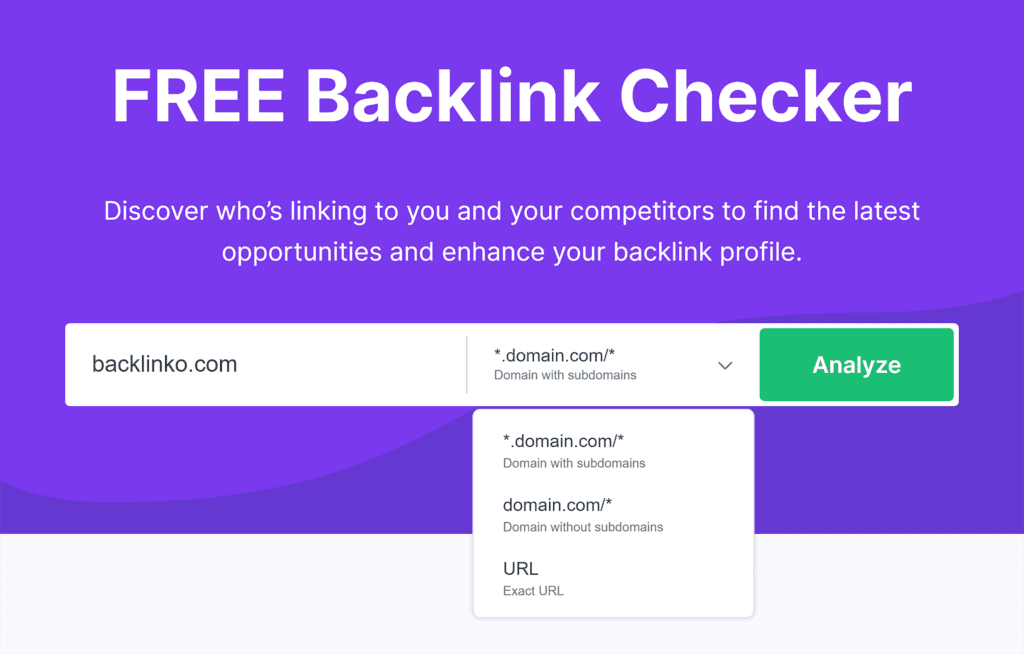Seo backlinks
Your main takeaway is that links still matter now.
What Are Backlinks? Definition & SEO Best Practices
Evan is a writer and entrepreneur with a background in technology and content marketing. He is currently the Head of Growth at Sagetap.io. Previous to Sagetap, he was was co-founder & CEO of the online publication Selling Signals, which was acqui.
Evan Tarver Contributor
Evan is a writer and entrepreneur with a background in technology and content marketing. He is currently the Head of Growth at Sagetap.io. Previous to Sagetap, he was was co-founder & CEO of the online publication Selling Signals, which was acqui.
Written By
Evan Tarver Contributor
Evan is a writer and entrepreneur with a background in technology and content marketing. He is currently the Head of Growth at Sagetap.io. Previous to Sagetap, he was was co-founder & CEO of the online publication Selling Signals, which was acqui.
Evan Tarver Contributor
Evan is a writer and entrepreneur with a background in technology and content marketing. He is currently the Head of Growth at Sagetap.io. Previous to Sagetap, he was was co-founder & CEO of the online publication Selling Signals, which was acqui.
Contributor
Lauren Holznienkemper Deputy Editor, SMB
Lauren (Hansen) Holznienkemper is a staff writer and deputy editor for the small business vertical at Forbes Advisor, specializing in reviewing and testing HR, payroll and recruiting solutions for small businesses. Using research and writing skills f.
Lauren Holznienkemper Deputy Editor, SMB
Lauren (Hansen) Holznienkemper is a staff writer and deputy editor for the small business vertical at Forbes Advisor, specializing in reviewing and testing HR, payroll and recruiting solutions for small businesses. Using research and writing skills f.
Lauren Holznienkemper Deputy Editor, SMB
Lauren (Hansen) Holznienkemper is a staff writer and deputy editor for the small business vertical at Forbes Advisor, specializing in reviewing and testing HR, payroll and recruiting solutions for small businesses. Using research and writing skills f.
Lauren Holznienkemper Deputy Editor, SMB
Lauren (Hansen) Holznienkemper is a staff writer and deputy editor for the small business vertical at Forbes Advisor, specializing in reviewing and testing HR, payroll and recruiting solutions for small businesses. Using research and writing skills f.
| Deputy Editor, SMB
Published: Feb 27, 2024, 2:00pm
Editorial Note: We earn a commission from partner links on Forbes Advisor. Commissions do not affect our editors’ opinions or evaluations.

Getty
Backlinks and SEO: Confusion in today’s landscape
- Link diversity (do your links come from multiple sites?).
- Relevance.
- Quality.
- Authority.
Technical aspects and Google’s preference for editorial (non-paid) links further impact effectiveness.
Links create PageRank, which helps elevate keyword rankings. Although Google no longer shows PageRank publicly, it still influences its algorithm.
How much? Opinions vary. Some believe PageRank is crucial, while others think its importance is all but dead.
Just check out this LinkedIn post:
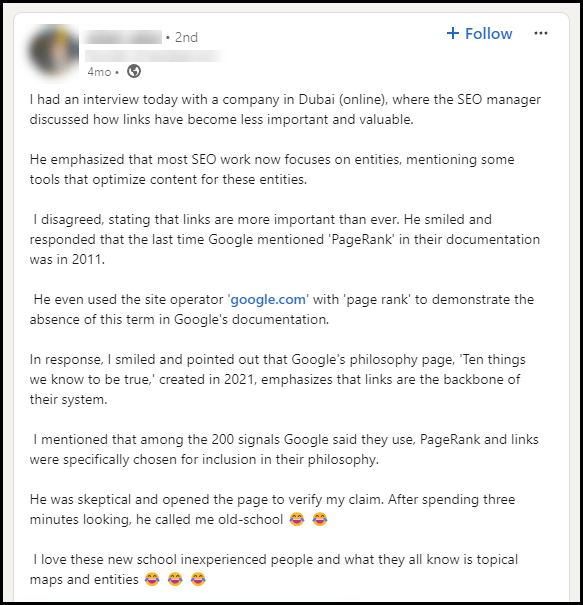
Such posts can lead to interesting discussions that surface interesting views:

Opinions on the importance of links vary widely, leaving many confused.
If you’re among the confused, know you aren’t alone.
So – are links as crucial as sellers claim? Or are links an industry scam costing thousands for unnecessary links?
The truth, as is typically the case, is somewhere in between.
Let’s further examine these perspectives and measure them against the facts.
How to check backlinks
There are two ways to check a website’s links.
The first method only works for sites that you own. Use the second one to check backlinks to another website or web page.
Checking backlinks to your website
A basic tool for checking your website backlinks is the free Google Search Console.
Once signed in, click “Links” on the sidebar. The number below “External links” shows the total number of unique backlinks to the website.

Google Search Console shows limited data in the app (top 1,000 links) and won’t show you some useful SEO metrics you could use to analyze your backlinks. To get more data for free, you can use Ahrefs Webmaster Tools.
Once you set up a project, click on Backlinks in the dashboard.

This will take you to the Backlinks report in the Site Explorer tool. This report will show all your backlinks and relevant backlink data.

Checking backlinks to another website
You can start with a tool like Ahrefs’ free backlink checker.
Just enter a domain or URL, and hit “Check backlinks.” Try it below.
Backlink Checker
Check backlinks to any website or webpage
You’ll see the total number of backlinks and referring domains (links from unique websites), plus the top 100 backlinks.

To see a full list of backlinks to any page or website, use Ahrefs’ Site Explorer. Let’s see how that would look for a competitor backlink analysis since replicating competitor’s backlinks is one of the most common link building tactic.
First, it’d be a good idea to let the tool find your organic competitors (sites that compete with you for the same keywords). This will uncover a comprehensive list of competitors, some of which you might not have been aware of previously.
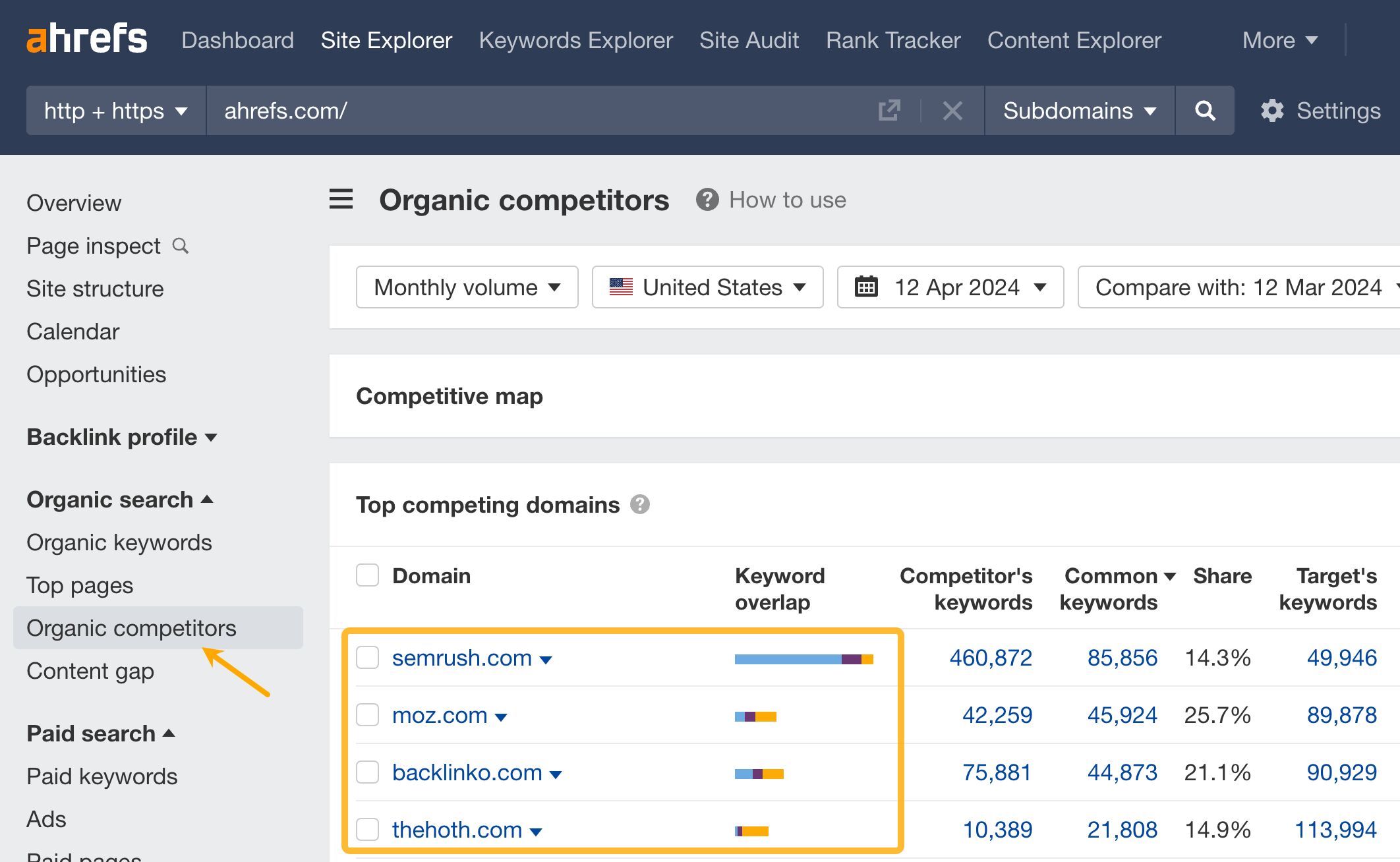
Now, click on the caret next to your competitor’s domain to view all of their backlinks in the Backlink report. You may want to use the Best links filter to show you links that likely have the biggest impact on your competitor’s performance right off the gate.
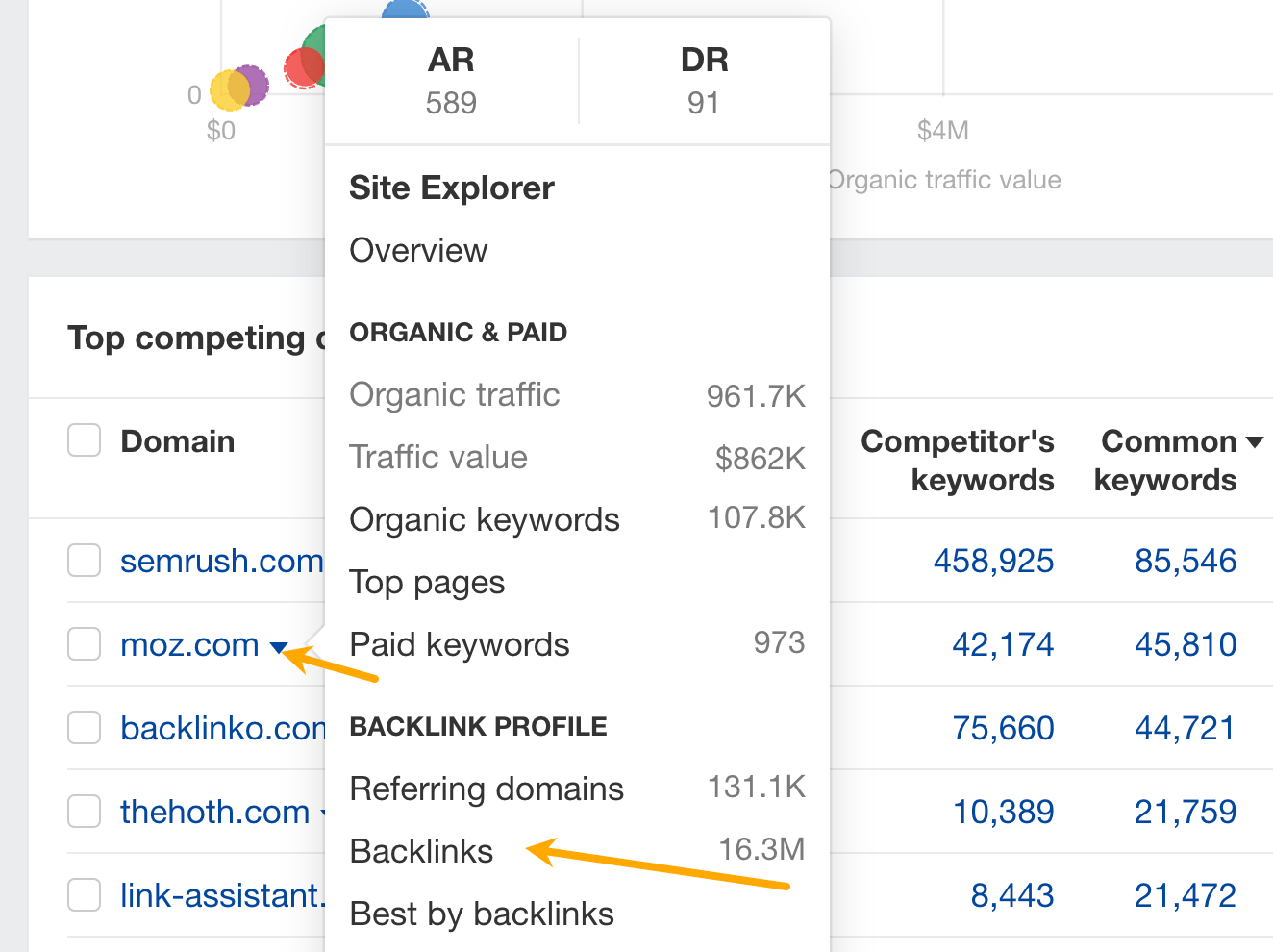

There is another way you can find and analyze competitors’ backlinks called Link intersect.
Instead of analyzing domains one by one, it analyzes them in bulk, showing shared backlinks (which is great for finding listicles to build links from) and domains that link to them but not to you (links from previously unliked domains are likely to have a bigger impact).
To enter the report, select a few competitors from the Organic competitors report and click Open in Link intersect.
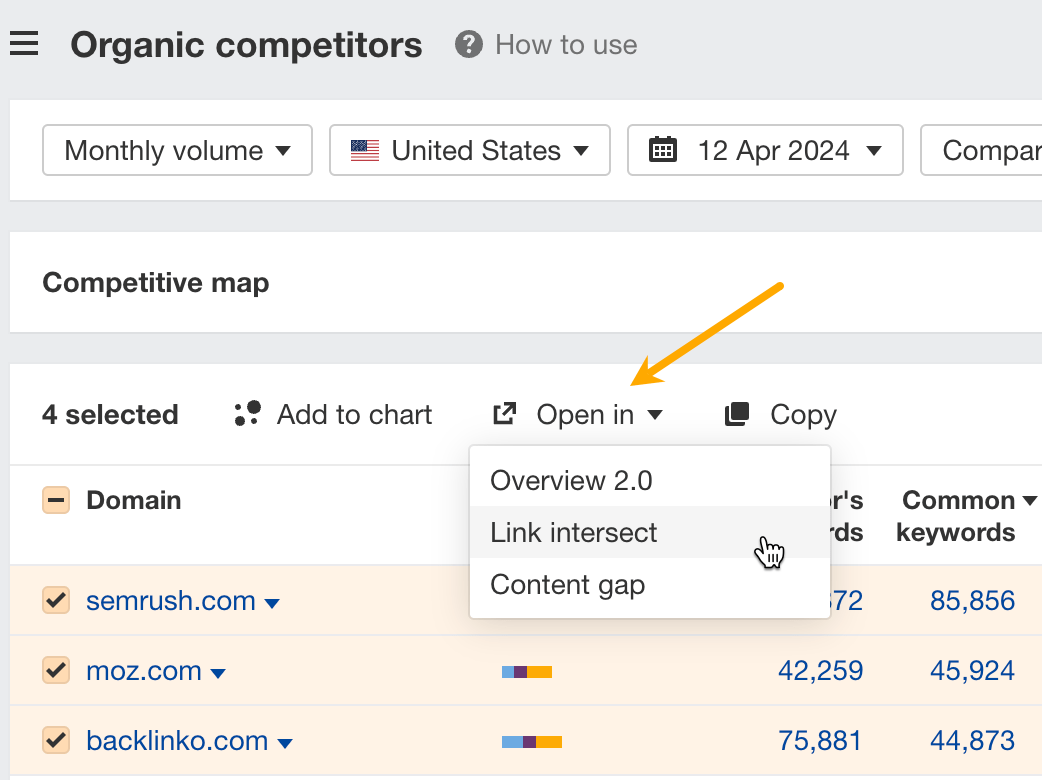
By default, the report will show you backlinks shared by your competitors. To see the backlink gap between you and them, click on Target and add your domain to the last field.
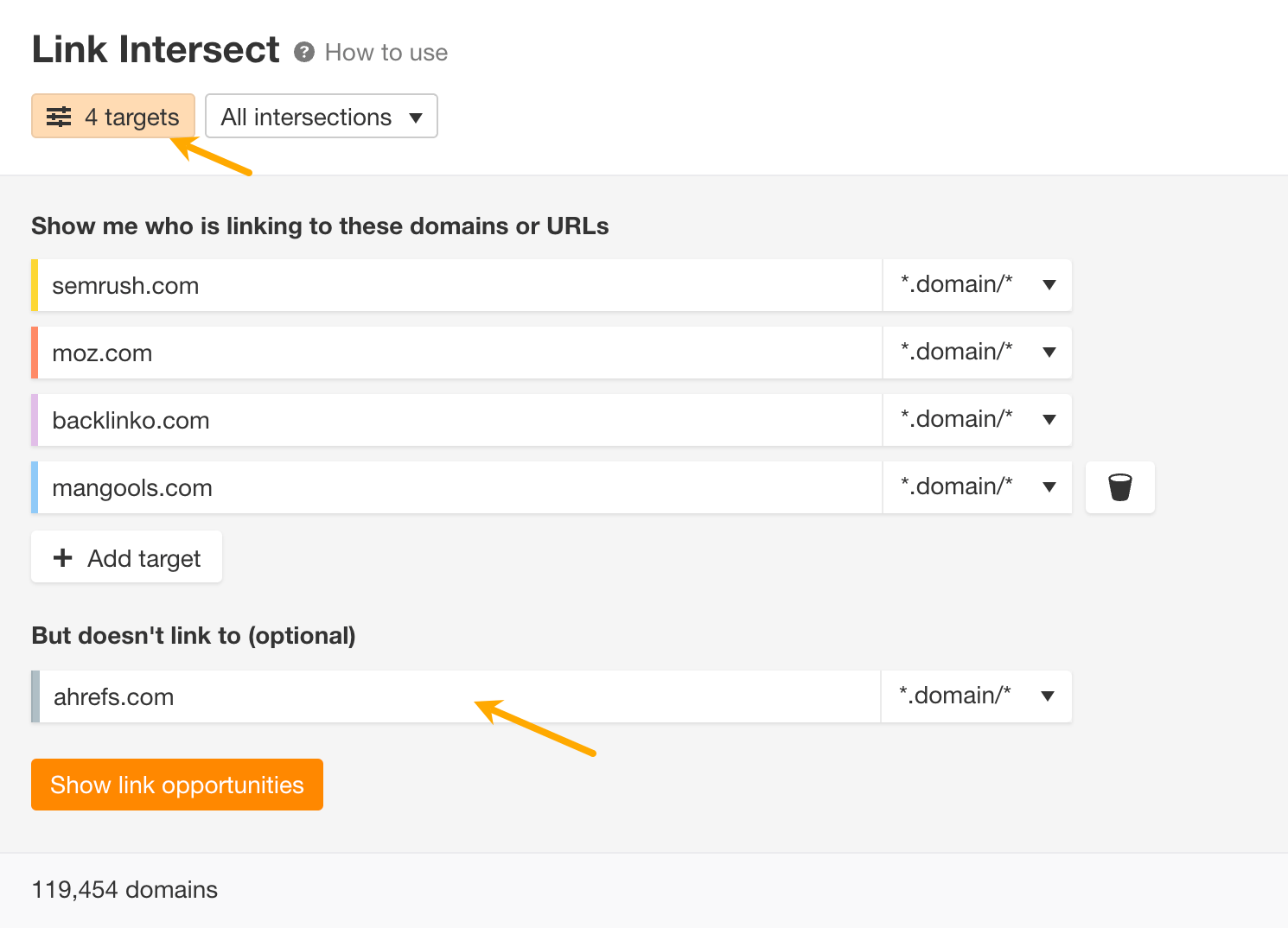
You can find more tips about competitive backlink analysis in these two guides:
- How to Find Your Competitors’ Backlinks (And Get Them for Yourself)
- How to Perform a Competitor Link Analysis in 3 Steps
How to Check Any Website’s Backlinks
Checking sites for backlinks can be helpful whether you’re planning a backlink building campaign or performing competitor research.
First, we’ll show you how to get insights about your own site’s backlink profile from Google Search Console (GSC).
But you can’t get information about other websites’ backlinks that way. So, we’ll cover how to do that with Semrush.
How to Check Your Backlinks with GSC
Find “Links” on the left-hand sidebar toward the bottom of the screen.
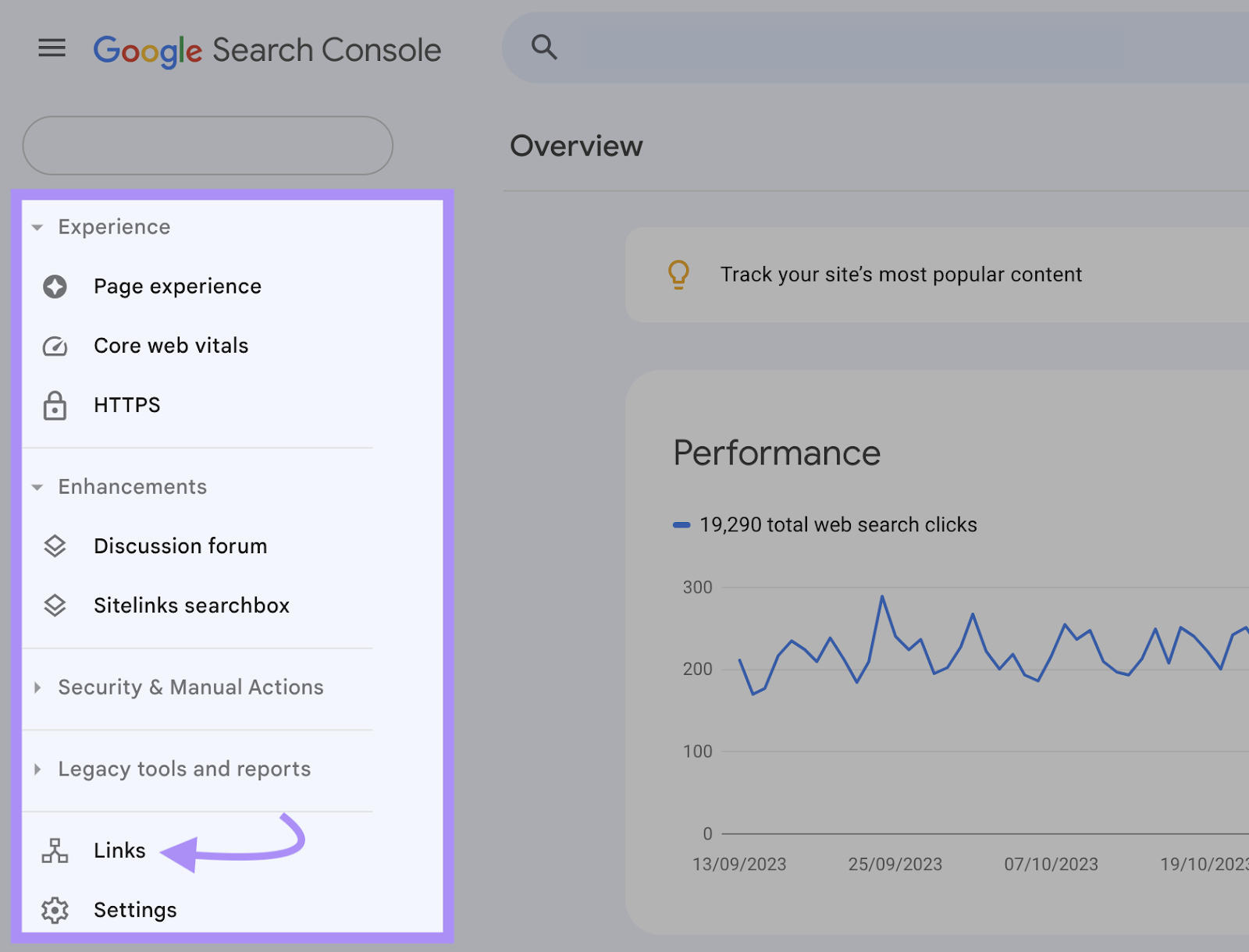
Under the “External links” column, you’ll see an overview of your site’s backlink profile.
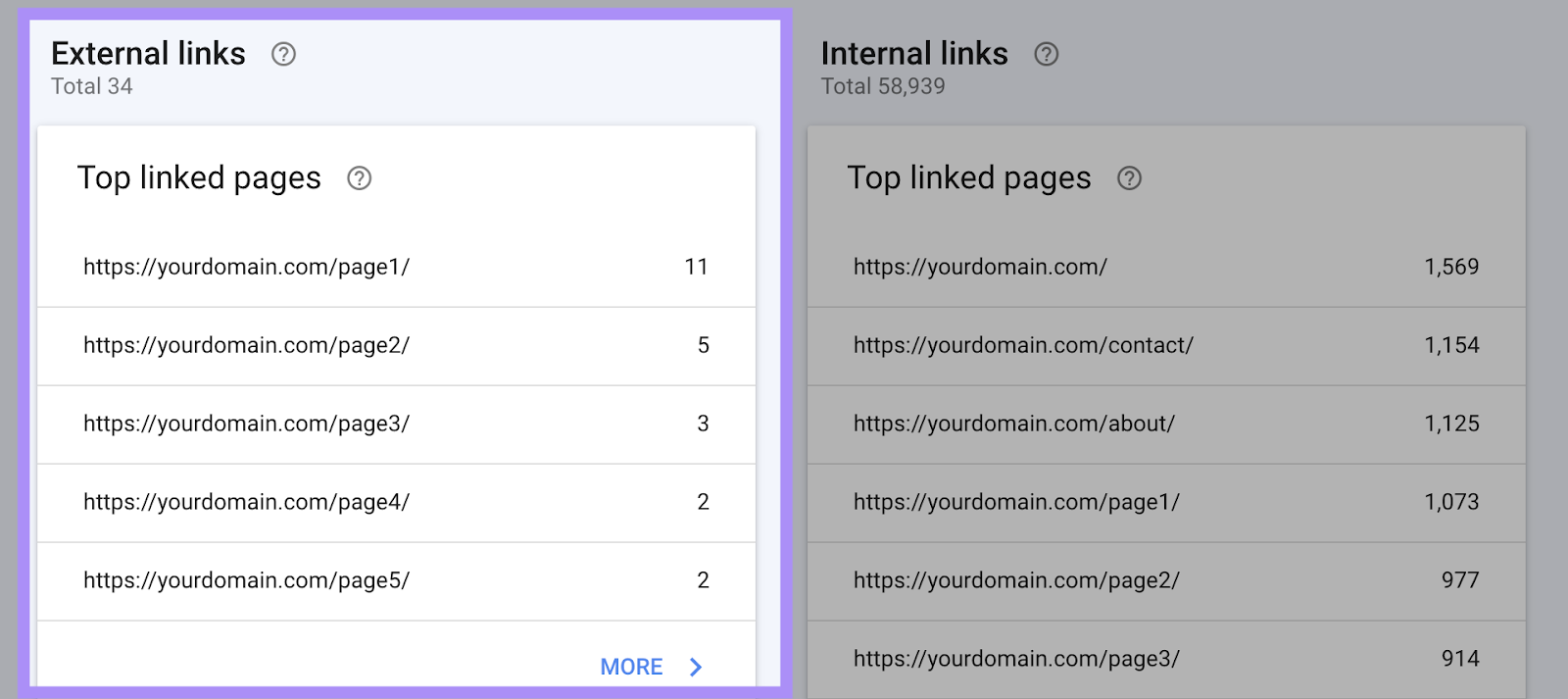
These reports include:
- Top linked pages: The pages on your site with the most backlinks
- Top linking sites: The sites that link to you the most
- Top linking text: The most common link anchor text used in your backlinks
Click “More” underneath any of these snippets to view the full report.
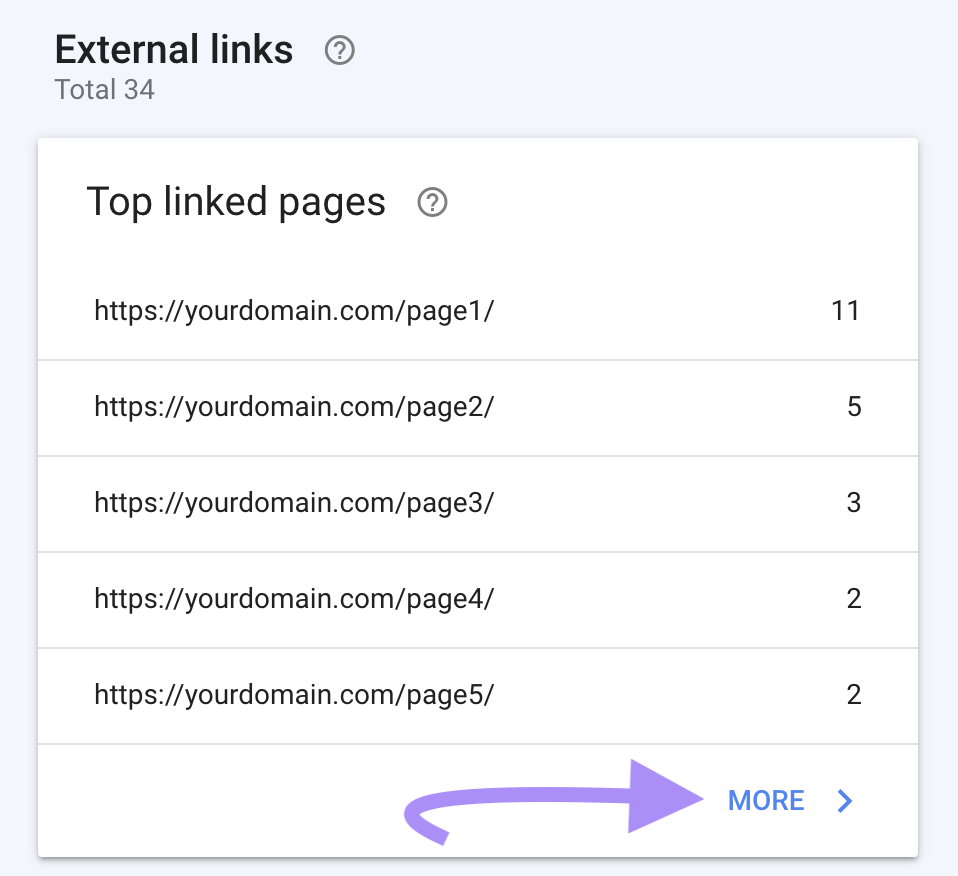
You can also export your site’s external links as a CSV file. Click the “Export External Links” button at the top-right of the screen.
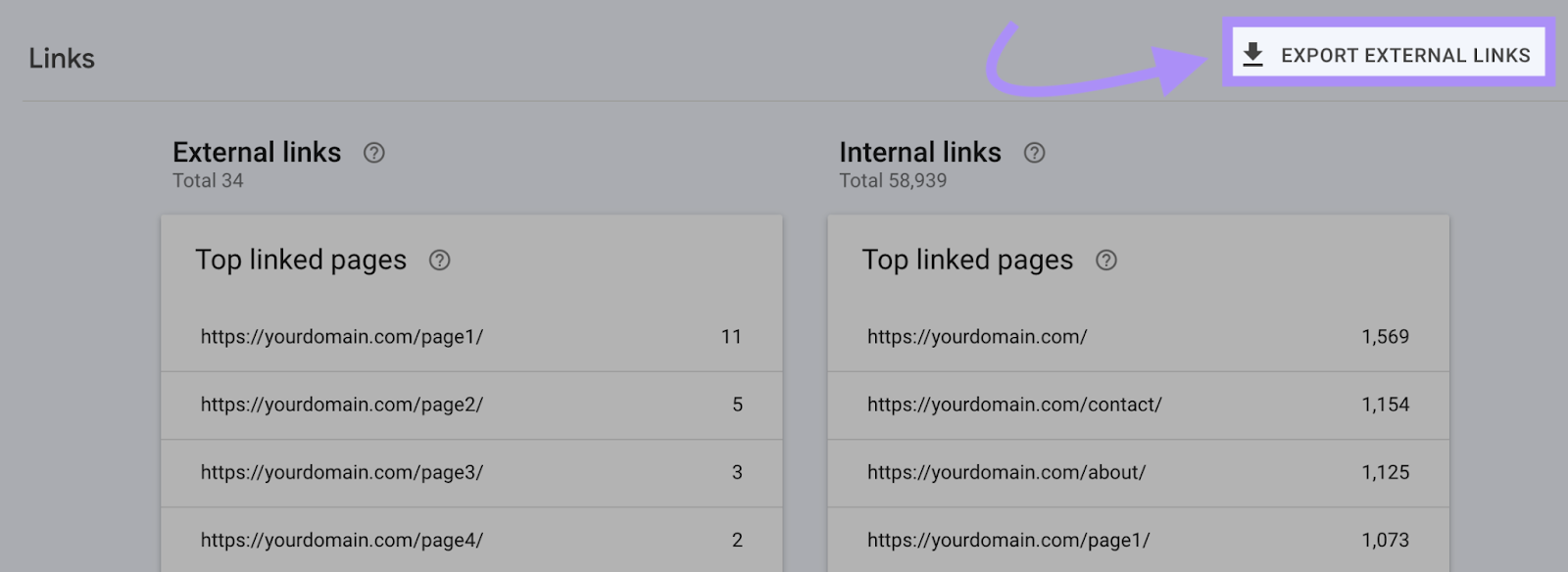
How to Analyze Backlinks with Semrush
Semrush’s Backlink Analytics tool can give you additional insights on your own site’s backlinks. It can also tell you about your competitors’ backlinks.
Start by choosing the website (or a specific URL) you want to review. Paste it into the search bar and click “Analyze.”

The primary metrics Backlink Analytics tracks are:
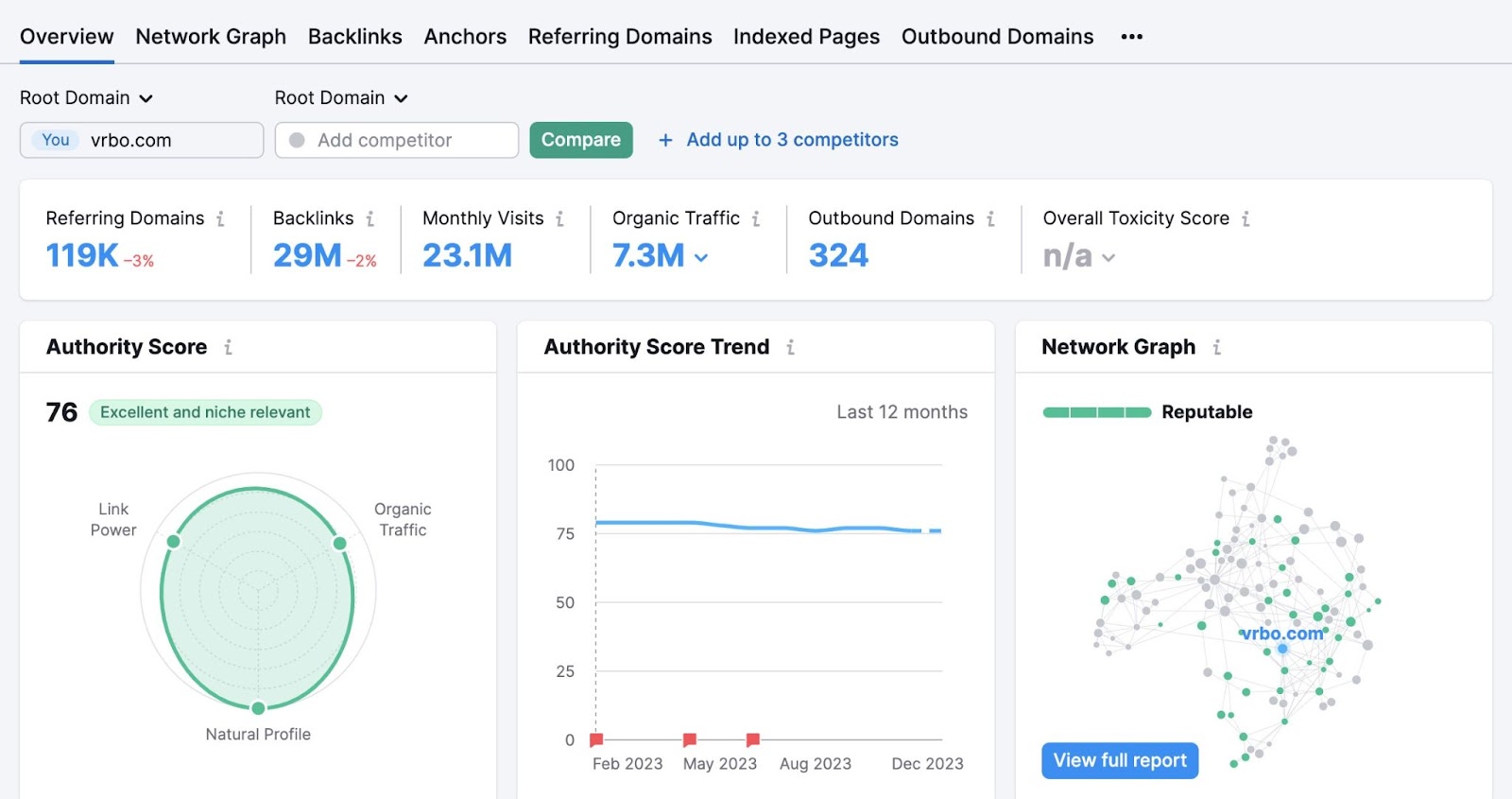
- Authority Score: A measure of overall domain quality
- Referring domains: The total number of referring domains pointing to your site
- Backlinks: The total number of backlinks pointing to your site
- Monthly visits: The number of unique visits to a root domain for the last month
- Organic Traffic: An estimate of traffic driven to a root domain from Google Search
- Outbound domains: The total number of domains the analyzed domain or URL points to
Click the blue number underneath each metric to view the full report.
To compare up to five sites at a time, add their root domains at the top:
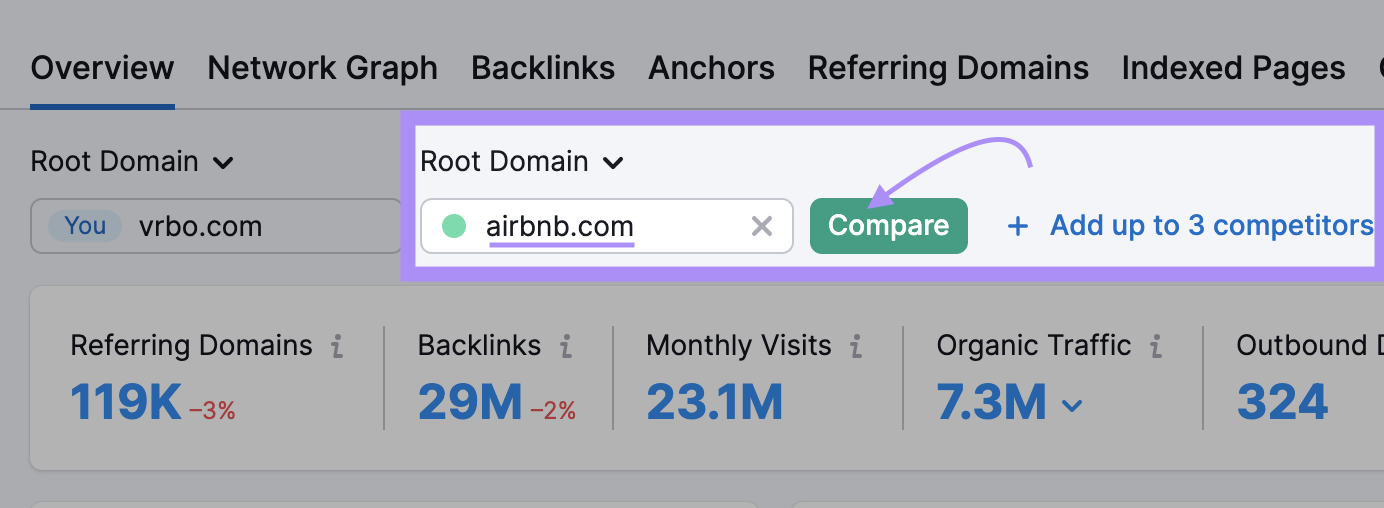
Then, scroll down to see how the sites compare to one another in terms of “Backlink Types,” “Link Attributes,” “Top Categories of Referring Domains,” and more.
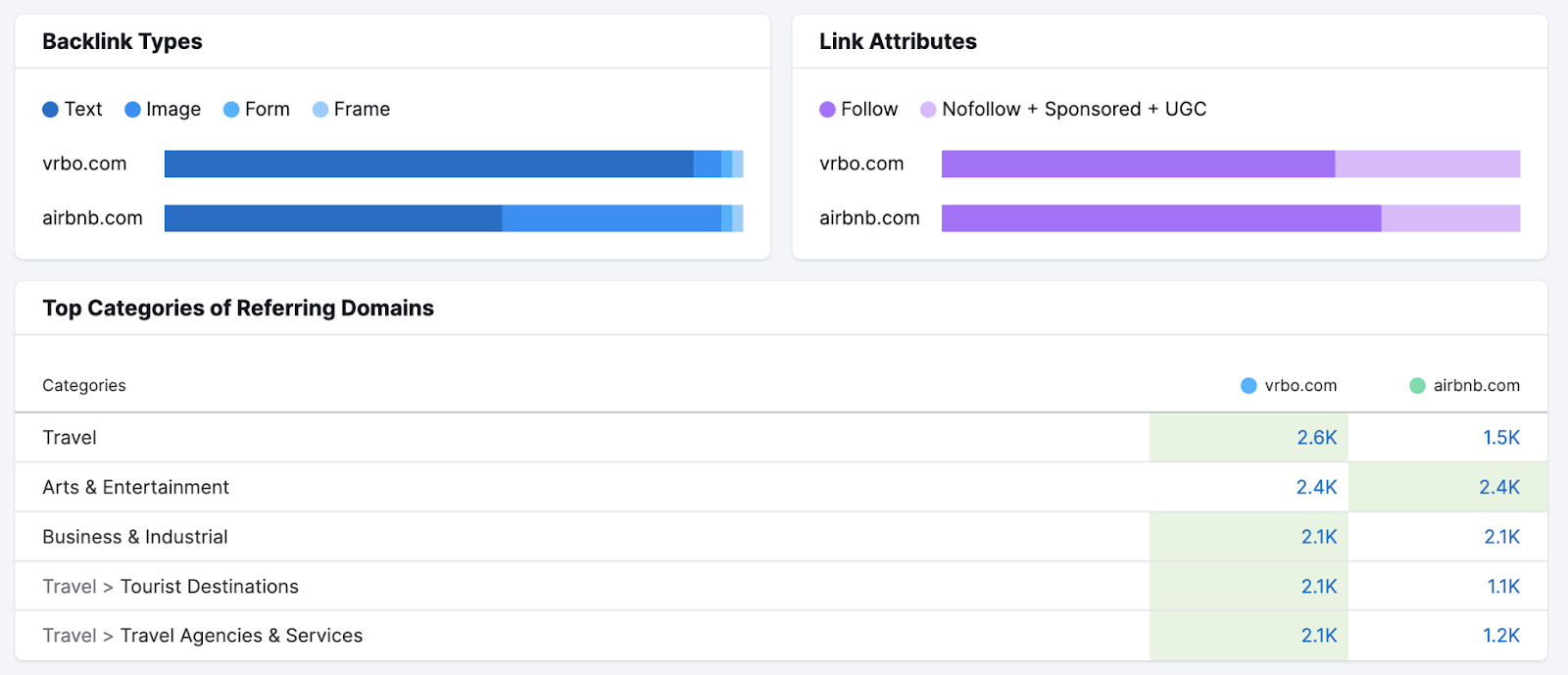
To save your data, click “Export to PDF” in the top-right corner. This is helpful if you want to further analyze backlinks or send competitor research to a client.

Whether you want to analyze your own backlinks or see how your competitors are doing, the Backlink Analytics tool is a great place to start.
Asegúrate de enlazar a otros sitios además de a los tuyos
Si ya has empezado a invertir tiempo y dinero en SEO, sabes que hay dos tipos importantes de enlaces: los backlinks y los enlaces internos. Aunque los backlinks ayudan a aumentar la autoridad de la página y el dominio, los enlaces internos pueden ayudar a los motores de búsqueda a comprender la estructura de tu sitio web y la importancia de las diferentes páginas. Sin embargo, hay un tercer tipo de enlace que siempre hay que tener en cuenta al intentar mejorar tus clasificaciones: los enlaces externos. Por enlace externo se entiende cuando tu sitio se vincula a otro sitio. Aunque parezca que estos enlaces quitan a visitantes de tu página, pueden ser increíblemente beneficiosos para el SEO.
Los enlaces externos pueden mejorar tu credibilidad al permitirte citar tus fuentes y proporcionar enlaces para referencias mientras ayuda a los motores de búsqueda a determinar la relevancia y utilidad de tus páginas. ¿Quieres un mejor sitio web SEO? Dado que hay tantos aspectos diferentes del SEO que considerar, incluidos los muchos tipos de oportunidades de vinculación, es posible que necesites ayuda. Mailchimp facilita la creación de backlinks ayudándote a crear una lista de difusión de sitios web a los que puedes dirigirte. También puedes ganar backlinks de forma pasiva creando contenido útil y autorizado utilizando el creador de sitios web de Mailchimp para actualizar tu blog y páginas de destino para mejorar tu estrategia de SEO y marketing de contenido.
¿Todo listo para probar lo que nos lanzó a la fama?
Crea campañas de correo electrónico personalizadas, mide el rendimiento y convierte la información en resultados con las herramientas de marketing por correo electrónico de Mailchimp.
La importancia de la construcción de enlaces
Las piedras angulares del SEO son la investigación de palabras clave, la optimización en la página y la adquisición de backlinks. Hacer una cosa sin las otras perjudicará los resultados. Pero entre ellas, la adquisición de backlinks es probablemente la más importante. Los enlaces no solo son buenos para el SEO. También pueden ser buenos para darse a conocer y dirigir el tráfico. La construcción de enlaces debe ser una parte importante de tu estrategia de SEO.
La plataforma de marketing todo en uno de Mailchimp puede ayudarte a ganar más backlinks proporcionándote las herramientas para crear correos electrónicos de primera calidad. Con los diseños de correo electrónico profesionales al alcance de tu mano, puedes captar la atención de los destinatarios y presentar tu marca durante el proceso de creación de enlaces.
What Types of Backlinks are Valuable?
Not all backlinks are created equal.
In other words, if you want to rank higher in the SERPs, focus on quality backlinks.
Put another way:
A single-quality backlink can be more powerful than 1,000 low-quality backlinks.
As it turns out, high-quality backlinks tend to share the same key traits.
Trait #1: They Come From Trusted, Authoritative Websites
Would you rather get a backlink from Harvard… or a random guy’s website?
As it turns out, Google feels the same way.
This concept is known as “Domain Authority”. Essentially, the more authority a site has, the more authority it can pass on to your site (via a link).
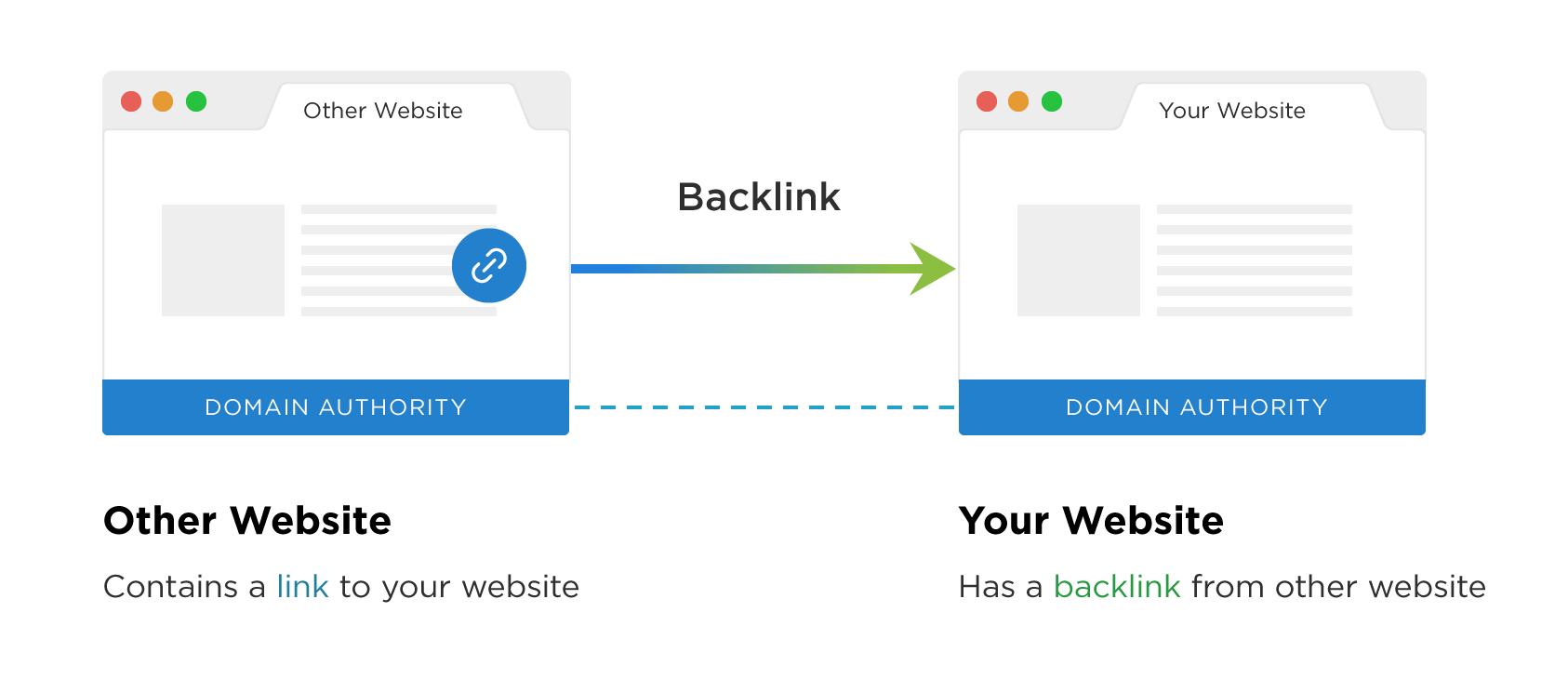
For example, here’s a link that I got from TechCrunch.
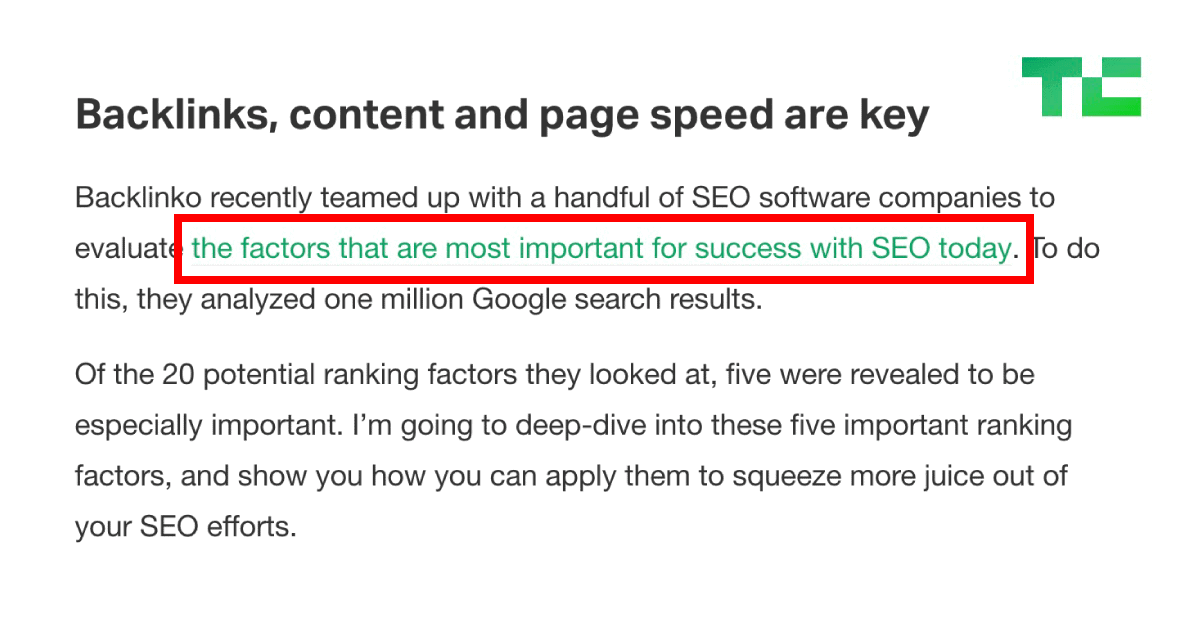
According to Semrush, TechCrunch is an extremely authoritative domain.
Because that link comes from an authority site, Google puts lots of weight on it. In fact, I noticed a boost in my organic search engine traffic right after TechCrunch linked to me.
Are these links hard to get? Definitely.
Are they worth it? Absolutely.
Trait #2: They Include Your Target Keyword In The Link’s Anchor Text
As a reminder, anchor text is the visible text part of a link.

In general, you want your links to have anchor text that includes your target keyword.
In fact, a recent industry study found a correlation between keyword-rich anchor text and higher rankings for that keyword.

Now, a quick word of warning:
You don’t want to go overboard with keyword-rich anchor text. In fact, Google has a filter in their algorithm called “Google Penguin”.
Google Penguin filters out websites that use black hat link building strategies. And it specifically focuses on sites that build backlinks with exact match anchor text.
Trait #3: The Site (and Page) Linking to You Is Topically Related To Your Site
When a website links to another website, Google wants to see that the two sites are related.
This makes sense if you think about it:
Imagine you just published an article about running a marathon.
In that case, Google will put MUCH more weight on links from sites about marathons, running, fitness vs. sites about fishing, unicycles, and digital marketing.
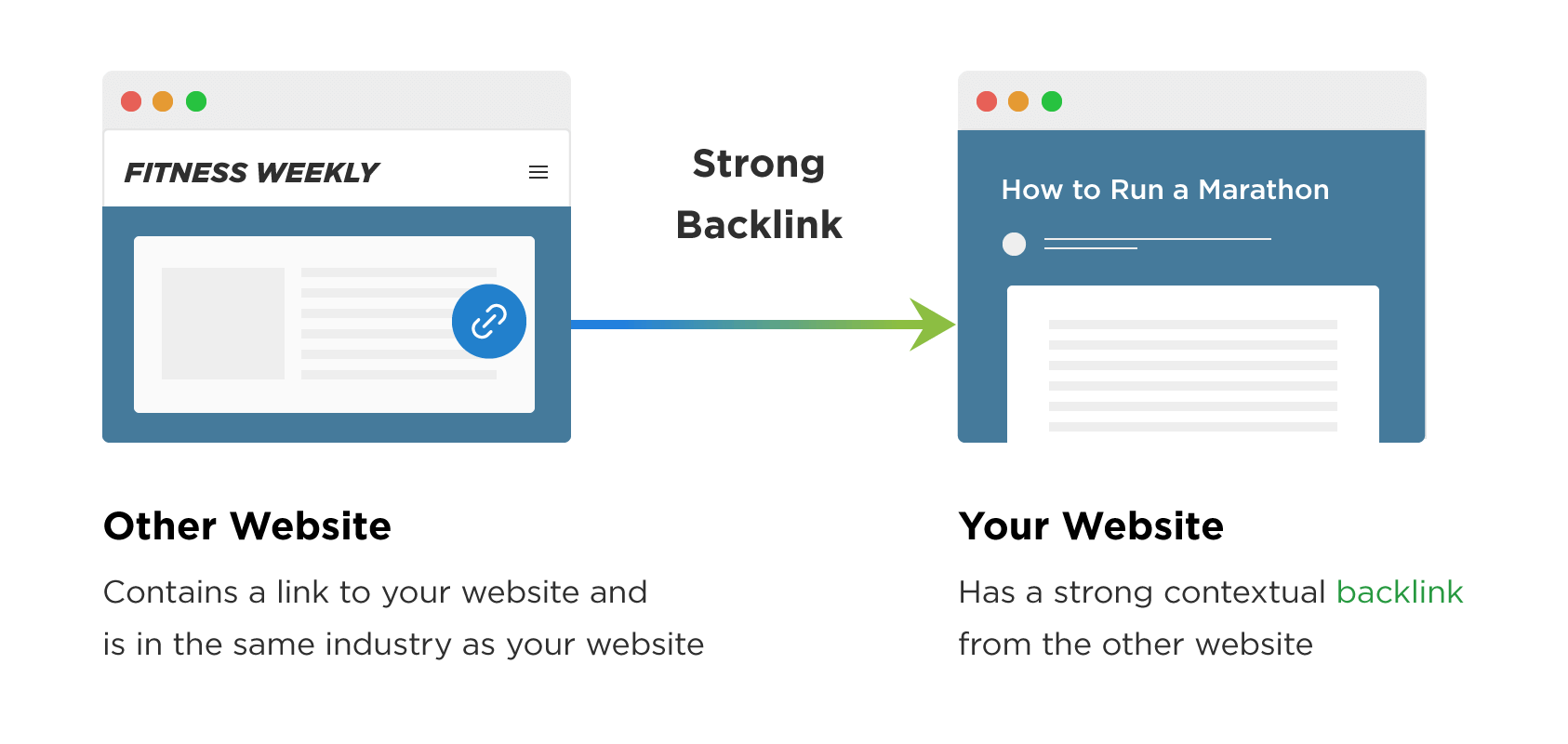
Trait #4: The Link Is a “Dofollow” Link
Google and other search engines ignore links with the “nofollow” tag attached to it.

(In other words, nofollow links don’t count search engine ranking algorithms).
Fortunately, the vast majority of links on the web are “dofollow” links.
And most of the links that have the nofollow tag aren’t that valuable to begin with. For example, links from these sources tend to be nofollow:
- Blog comments
- Press releases
- Paid advertisements
These links aren’t super helpful for SEO anyway, so it’s not a big deal that they’re nofollow.
Trait #5: The Link Is From a Domain That Hasn’t Linked to You Before
Let’s say you get a link from Website A.
Well, let’s say Website A links to you again. And again. And again.
Are the 2nd, 3rd and 4th links as powerful as the first one?
As it turns out, links from the same website have diminishing returns.

Or put another way:
It’s usually better to get 100 links from 100 different websites than 1,000 links from the same website.
In fact, our search engine ranking correlation study found that the number of sites linking to you (not the total number of backlinks) correlated with Google rankings more than any other factor.
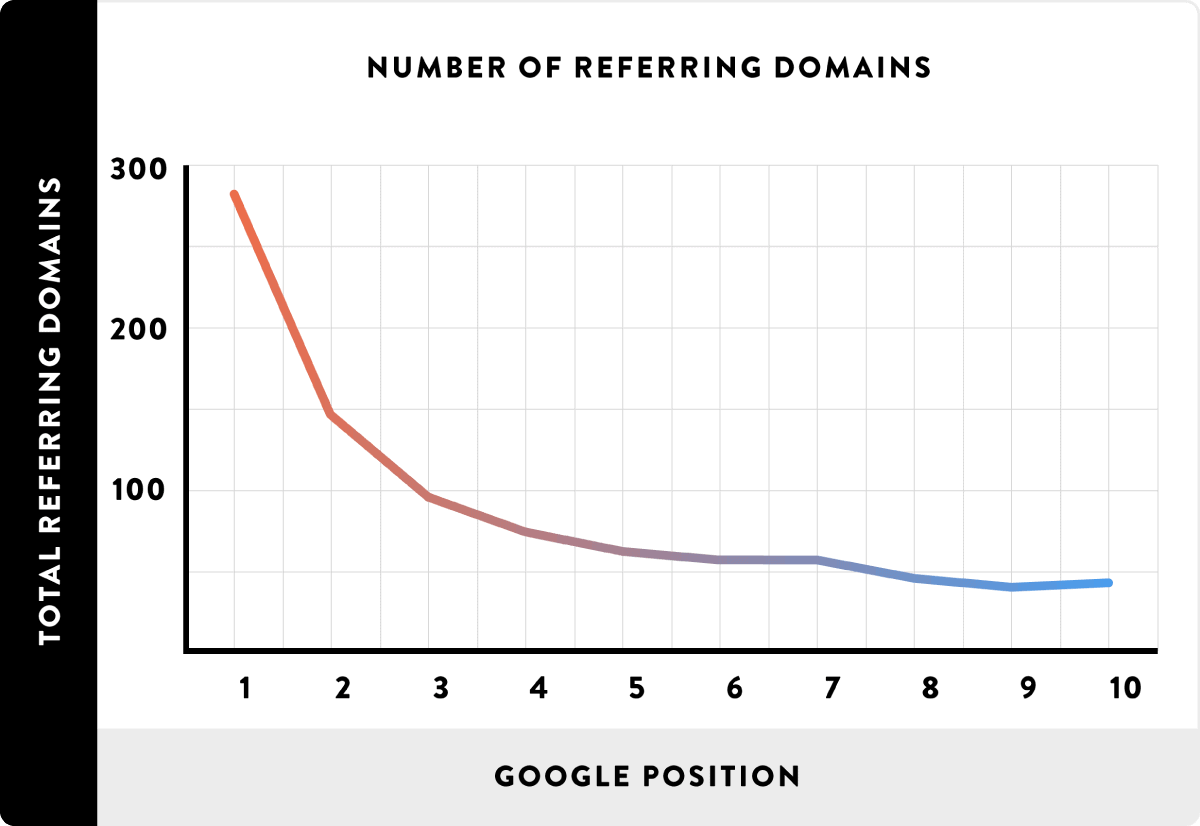
Now that you’ve seen what types of backlinks are the most helpful for your Google rankings, it’s time for me to show you how to start building them.
Bonus Strategy #2: Send “Feeler” Emails
When it comes to email outreach, you have two options:
Option #1: Ask people for links in your first email
Option #2: Use a “feeler” email
From running hundreds of link building campaigns, I’ve found that both approaches can work.
But I’ve also found that so-called “Feeler” emails increase conversions by 40%+.
So: what are “Feeler” emails?
Feeler emails are messages you send to prospects without asking for a link.
(You’re “feeling out” whether or not they’re receptive to your outreach… before you make a link pitch.)
Here’s a real-life example:

See how Mike doesn’t ask for a link? Instead, he asks the person if they’d like to see it first.
IF they say “yes”, you send them your pitch:

In Mike’s case, the “Feeler” email got 40% more responses vs. asking for a link in the first email.
Источники:
https://www.forbes.com/advisor/business/software/what-are-backlinks/
https://searchengineland.com/backlinks-seo-importance-442529
https://ahrefs.com/blog/what-are-backlinks/
https://www.semrush.com/blog/what-are-backlinks/
https://mailchimp.com/resources/what-is-backlinking-and-why-is-it-important-for-seo/
https://mailchimp.com/marketing-glossary/backlinks/
https://backlinko.com/hub/seo/backlinks
https://backlinko.com/high-quality-backlinks

